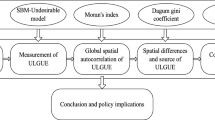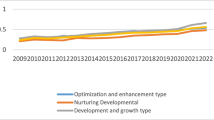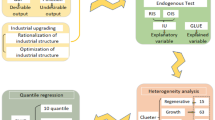Abstract
Convergence analysis of China’s urban green land-use efficiency (GLUE) will help to explore whether regional differences in GLUE determined by regional economic development and imbalance of resource endowments gradually decrease over time. We construct a DEA model considering variable returns to scale to measure Chinese urban GLUE, and discuss the convergence of Chinese urban GLUE. We find that Chinese urban GLUE is generally low. GLUE of eastern cities is the best. GLUE of non-resource-based (NRB) cities is higher than that of resource-based (RB) cities. GLUE of Pearl River Delta Economic Zone is the highest, while that of Comprehensive Economic Zone of Central 6 Provinces is the lowest. Chinese urban GLUE is mainly affected by technological change. Chinese urban GLUE shows absolute and conditional β convergence, and the gap of GLUE between cities is constantly narrowing. Cities in different locations, resource dependence degrees, and economic zones have different convergence rates. The conclusions help the Chinese government to formulate policies for intensive land use, improve national GLUE, and promote urban intensive and high-quality development.







Similar content being viewed by others
References
Banker RD, Charnes A, Cooper WW (1984) Some models for estimating technical and scale inefficiencies in data envelopment analysis. Manag Sci 30(9):1078–1092
Bi GB, Song W, Zhou P et al (2014) Does environmental regulation affect energy efficiency in China’s thermal power generation? Empirical evidence from a slacks-based DEA model. Energy Policy 66:537–546
Bigerna S, Bollino CA, Polinori P (2021) Convergence in renewable energy sources diffusion worldwide. J Environ Manag 292:112784
Casu B, Girardone C (2010) Integration and efficiency convergence in EU banking markets. Omega 38(5):260–267
Charnes A, Cooper WW, Rhodes E (1978) Measuring the efficiency of decision making units. Eur J Oper 2(6):429–444
Chen Y, Chen Z, Xu G, Tian Z (2016) Built-up land efficiency in urban China: insights from the general land use plan (2006–2020). Habitat Intl 51:31–38
Chivu L, Andrei JV, Zaharia M et al (2020) A regional agricultural efficiency convergence assessment in Romania–appraising differences and understanding potentials. Land Use Policy 99:104838
Fukuyama H, Weber WL (2009) A directional slacks-based measure of technical inefficiency. Socio-Econ Plann Sci 1:274–287
Gao X, Zhang A, Sun Z (2020) How regional economic integration influence on urban land use efficiency? A case study of Wuhan metropolitan area, China. Land Use Policy 90:104329
Ge K, Zou S, Chen D et al (2021) Research on the spatial differences and convergence mechanism of urban land use efficiency under the background of regional integration: a case study of the Yangtze River Economic Zone, China. Land 10(10):1100
Guccio C, Martorana MF, Monaco L (2016) Evaluating the impact of the Bologna Process on the efficiency convergence of Italian universities: a non-parametric frontier approach. J Prod Anal 45(3):275–298
Hao Y, Peng H (2017) On the convergence in China’s provincial per capita energy consumption: new evidence from a spatial econometric analysis. Energy Econ 68:31–43
Huang J, Yu Y, Ma C (2018) Energy efficiency convergence in China: catch-up, lock-in and regulatory uniformity. Environ Resour Econ 70(1):107–130
Kuang B, Lu X, Zhou M et al (2020) Provincial cultivated land use efficiency in China: empirical analysis based on the SBM-DEA model with carbon emissions considered. Technol Forecast Soc Chang 151:119874
Kuo HF, Tsou KW (2015) Application of environmental change efficiency to the sustainability of urban development at the neighborhood level. Sustainability 7(8):10479–10498
Li X, Zhang Q (2015) AHP-based resources and environment efficiency evaluation index system construction about the west side of Taiwan Straits. Ann Oper Res 228(1):97–111
Liu P, Ravenscroft N (2017) Collective action in implementing top-down land policy: the case of Chengdu, China. Land Use Policy 65:45–52
Liu Y (2018) Introduction to land use and rural sustainability in China. Land Use Policy 74:1–4
Lu X, Kuang B, Li J (2018) Regional difference decomposition and policy implications of China’s urban land use efficiency under the environmental restriction. Habitat Intl 77:32–39
Mendez C (2020) Regional efficiency convergence and efficiency clusters. Asia-Pacific J Region Sci 4(2):391–411
Meng Y, Zhang FR, An PL et al (2008) Industrial land-use efficiency and planning in Shunyi, Beijing. Landsc Urban Plan 85(1):40–48
Mohammadi H, Ram R (2012) Cross-country convergence in energy and electricity consumption, 1971–2007. Energy Econ 34(6):1882–1887
Morales-Lage R, Bengochea-Morancho A, Camarero M et al (2019) Club convergence of sectoral CO2 emissions in the European Union. Energy Policy 135:111019
Osman T, Divigalpitiya P, Arima T (2016) Driving factors of urban sprawl in Giza Governorate of Greater Cairo Metropolitan Region using AHP method. Land Use Policy 58:21–31
Pan X, Liu Q, Peng X (2015) Spatial club convergence of regional energy efficiency in China. Ecol Indic 51:25–30
Panopoulou E, Pantelidis T (2009) Club convergence in carbon dioxide emissions. Environ Resour Econ 44(1):47–70
Payne JE, Apergis N (2021) Convergence of per capita carbon dioxide emissions among developing countries: evidence from stochastic and club convergence tests. Environ Sci Pollut Res 28(26):33751–33763
Shu B, Zhang H, Li Y et al (2014) Spatiotemporal variation analysis of driving forces of urban land spatial expansion using logistic regression: a case study of port towns in Taicang City, China. Habitat Intl 43:181–190
Sun H, Kporsu AK, Taghizadeh-Hesary F et al (2020) Estimating environmental efficiency and convergence: 1980 to 2016. Energy 208:118224
Tan S, Hu B, Kuang B et al (2021) Regional differences and dynamic evolution of urban land green use efficiency within the Yangtze River Delta. China. Land Use Policy 106:105449
Tone K (2001) A slacks-based measure of efficiency in data envelopment analysis. Eur J Oper Res 130(3):498–509
Tone K (2003) Dealing with undesirable outputs in DEA: a slacks based measure (SBM) approach. Grips Res Res Rep Ser 8:44–45
Von Lyncker K, Thoennessen R (2017) Regional club convergence in the EU: evidence from a panel data analysis. Empir Econ 52(2):525–553
Wang R, Wang Q, Yao S (2021) Evaluation and difference analysis of regional energy efficiency in China under the carbon neutrality targets: Insights from DEA and Theil models. J Environ Manag 293:112958
Wei YD (2015) Zone fever, project fever: Development policy, economic transition, and urban expansion in China. Geogr Rev 105(2):156–177
Wey WM, Hsu J (2014) New urbanism and smart growth: towad achieving a smart National Taipei University District. Habitat Intl 42:164–174
Wu C, Wei YD, Huang X et al (2017) Economic transition, spatial development and urban land use efficiency in the Yangtze River Delta, China. Habitat Intl 63:67–78
Wu J, Li M, Zhu Q et al (2019) Energy and environmental efficiency measurement of China’s industrial sectors: a DEA model with non-homogeneous inputs and outputs. Energy Econ 78:468–480
Xie H, Chen Q, Wang W et al (2018) Analyzing the green efficiency of arable land use in China. Technol Forecast Soc Chang 133:15–28
Xie H, Wang W (2015a) Exploring the spatial-temporal disparities of urban land use economic efficiency in China and its influencing factors under environmental constraints based on a sequential slacks-based model. Sustainability 7(8):10171–10190
Xie H, Wang W (2015b) Spatiotemporal differences and convergence of urban industrial land use efficiency for China’s major economic zones. J Geogr Sci 25(10):1183–1198
Yang G, Yang D (2020) Investigating industrial water-use efficiency in mainland China: an improved SBM-DEA model. J Environ Manag 270:110859
Yang H, Wu Q (2019) Land use eco-efficiency and its convergence characteristics under the constraint of carbon emissions in China. Int J Environ Res Public Health 16(17):3172
Yu J, Zhou K, Yang S (2019) Land use efficiency and influencing factors of urban agglomerations in China. Land Use Policy 88:104143
Zhao Z, Bai Y, Wang G et al (2018) Land eco-efficiency for new-type urbanization in the Beijing-Tianjin-Hebei Region. Technol Forecast Soc Chang 137:19–26
Zhu X, Li Y, Zhang P et al (2019a) Temporal–spatial characteristics of urban land use efficiency of China’s 35 mega cities based on DEA: decomposing technology and scale efficiency. Land Use Policy 88:104083
Zhu X, Zhang P, Wei Y et al (2019b) Measuring the efficiency and driving factors of urban land use based on the DEA method and the PLS-SEM model—a case study of 35 large and medium-sized cities in China. Sustain Cities Soc 50:101646
Zitti M, Ferrara C, Perini L et al (2015) Long-term urban growth and land use efficiency in Southern Europe: implications for sustainable land management. Sustainability 7(3):3359–3385
Availability of data and materials
Data will be available upon request.
Funding
This research was supported by Scientific Research Project of Hunan Provincial Education Department in year 2019 (No. 19B090).
Author information
Authors and Affiliations
Contributions
Cenjie Liu and Guomei Zhao conceptualized the study and participated in the study design. Cenjie Liu wrote the manuscript. Guomei Zhao collected the data and conducted the statistical analysis. All authors read and approved the final manuscript.
Corresponding author
Ethics declarations
Ethics approval and consent to participate
Not applicable.
Consent for publication
Not applicable.
Competing interests
The authors declare no competing interests.
Additional information
Responsible Editor: Philippe Garrigues
Publisher’s note
Springer Nature remains neutral with regard to jurisdictional claims in published maps and institutional affiliations.
Rights and permissions
About this article
Cite this article
Liu, C., Zhao, G. Convergence analysis of Chinese urban green land-use efficiency. Environ Sci Pollut Res 29, 89469–89484 (2022). https://doi.org/10.1007/s11356-022-21841-3
Received:
Accepted:
Published:
Issue Date:
DOI: https://doi.org/10.1007/s11356-022-21841-3




